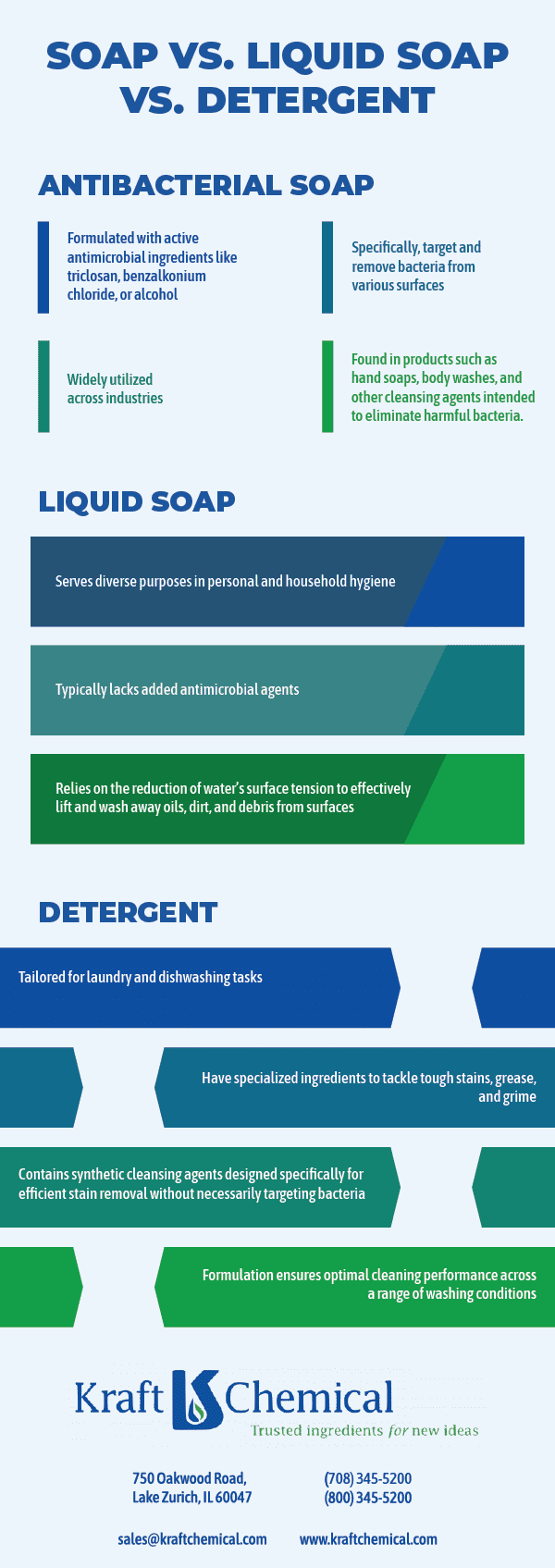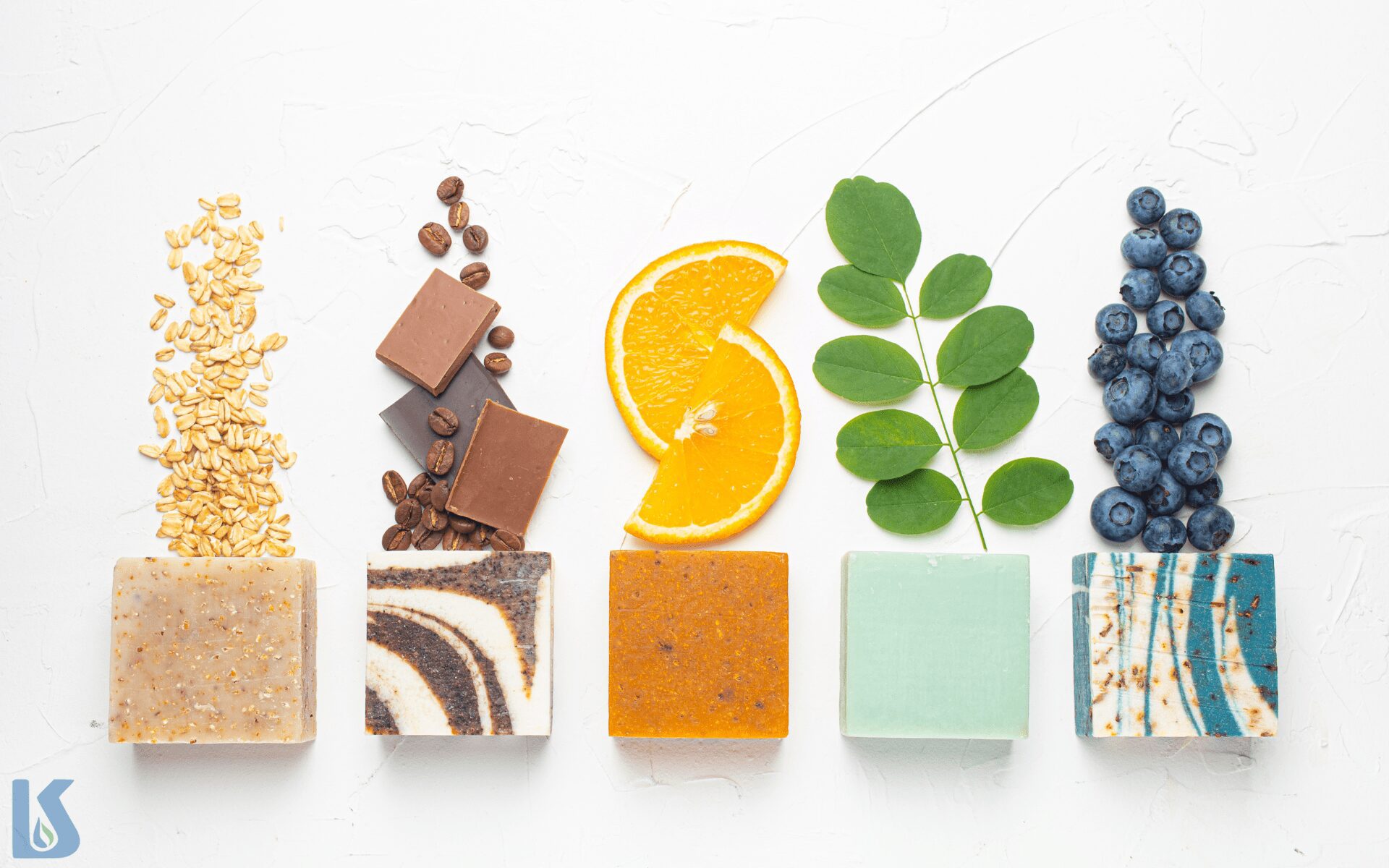Supply Your Soap With Top-Tier Chemicals From Kraft Chemical
From ancient civilizations to modern industries, soap has remained a fundamental tool for cleanliness. As techniques evolved from basic animal fat and ash concoctions to sophisticated chemical processes, the quest for effective cleansing has persisted. Today, businesses seeking quality soap chemicals turn to suppliers like Kraft Chemical. In this exploration of soap-making, we’ll uncover its rich history and the pivotal role of chemical advancements in shaping its modern forms.
The Evolution Of Cleaning
The chemical compounds used to make soap date back to ancient times, starting with fatty acids from sheep, goats, cows, and other livestock from the early Mesopotamian and Roman eras. Soap was first made with animal fat and wood ash in ancient times. Then, soap was evolved by Nicolas Leblanc, a French soap maker in the 1790s who extracted sodium hydroxide from salt (sodium chloride) and replaced the need for wood ash in soap making. However, the soap-making process, otherwise known as the saponification process, was not established until the 1820s by another French chemist Eugene-Michel Chevreul.
Choose Kraft Chemical for Premium Soap-Making ChemicalsWhat Is Soap Formula?
The chemical formula for soap is C17H35COO– plus a metal cation, either Na+ or K+.
Originally, soap production relied on combining potassium hydroxide with animal or vegetable fats, yielding potassium salts known as soft soaps. Over time, industrialization introduced sodium hydroxide, or lye, as the primary alkaline agent, resulting in the formation of sodium stearate, or hard soap. This shift from potassium to sodium soaps altered the consistency and solubility of the final product, with potassium soaps yield softer, more water-soluble variants.
Regardless of the base used, the fundamental principles remain: soap molecules exhibit hydrophilic heads attracted to water and hydrophobic tails repelled by it, allowing them to bond with both water and debris, reducing surface tension, and facilitating the emulsification and removal of dirt and grease. Today’s soap-making process continues to refine these ancient techniques, harnessing organic acids and alkaline chemicals to produce a diverse array of cleansing agents tailored to modern needs.

The Manufacturing Process of Soap
The manufacturing process of soap is a fascinating journey that transforms basic substances into a versatile cleaning agent. It begins with the extraction of fats and oils from both animal and plant sources. These raw materials serve as the building blocks for soap production. Fats and oils contain triglycerides, which are composed of three fatty acid molecules bonded to a glycerine molecule. Each fatty acid molecule comprises a carboxylic group and a hydrocarbon chain.
🗹 Saponification
The saponification process is the heart of soap production, and it involves the reaction of fats and oils with an alkali, such as sodium hydroxide (caustic soda) or potassium hydroxide (caustic potash). This chemical reaction breaks down the triglycerides into soap molecules and glycerine. The carboxylic groups of the fatty acids combine with the alkali to form the soap, while the glycerine is released as a byproduct.
In the saponification process, fats and oils are heated and mixed with the liquid alkali, resulting in the formation of a soap and water-glycerine mixture. The proportions of fats/oils and alkalis are carefully controlled to achieve the desired properties of the final soap product. Depending on the type of alkali used, the resulting soap can vary in hardness. Soaps made with sodium alkali tend to be hard and solid, while those made with potassium alkali are softer and more liquid.
🗹 Neutralization
Apart from saponification, another method employed in soap manufacturing is neutralization. This process involves hydrolyzing fats and oils with high-pressure steam to obtain crude fatty acids and glycerine. The fatty acids are then purified through distillation and neutralized with an alkali to produce soap.
The properties and effectiveness of soap can be influenced by various factors, including the type of alkali used, the ratio of fats/oils to alkali, and the presence of impurities. Additionally, the quality of water used in the manufacturing process can impact the performance of the soap. Hard water, which contains minerals like calcium and magnesium, can diminish the lathering and cleaning ability of soap. This is why detergent surfactants, which are less affected by hard water, are often preferred for cleaning purposes.
Guide to Chemicals in Soap Making
The chemicals used in soap making today will vary based on multiple factors including skin reactions, quality, price, and desired outcome. Some soaps focus on their antibacterial and antimicrobial properties whereas others focus on dry skin and eczema.
Soap Making Chemicals List
🗹 Sodium Lauryl Sulfate
Sodium Lauryl Sulfate (SLS) and Sodium Laureth Sulfate (SLES) are primary surfactants widely utilized in various personal care and household products. These compounds play a crucial role in the formulation of hand soaps, shampoos, toothpaste, cleaning products, and more. As anionic detergents and surfactants, SLS and SLES possess excellent cleansing properties, aiding in the breakdown of oils and dirt on the skin, thus facilitating their removal upon rinsing. Particularly noteworthy for their foaming capabilities, SLS and SLES contribute to the rich lathering experience commonly associated with personal care products like shampoos and soaps. SLS and SLES can be derived from natural sources such as palm kernel oil or coconut oil, aligning with the growing demand for environmentally friendly and sustainable chemical compounds.
🗹 Sodium Coco-Sulfate
Sodium Coco-Sulfate (SCS) is a surfactant commonly used in the skincare industry for its cleansing and foaming properties. Derived from coconut oil, SCS is considered a milder alternative to traditional sulfates like Sodium Lauryl Sulfate (SLS) and Sodium Laureth Sulfate (SLES). Its chemical composition and structure make it an effective yet gentle cleanser suitable for various skincare formulations.
🗹 Sodium Cocoyl Isethionate
Sodium Cocoyl Isethionate, also known as Baby Foam, is a surfactant made from Isethionic Acid and Coconut Oil. It’s a mild alternative to animal-derived sodium salts. It creates a rich, stable lather without drying the skin, making it suitable for various water-free, skincare, haircare, and bath products. It works well in both hard and soft water and is commonly used in liquid and bar shampoos, soaps, bath butter, and shower gels. Its gentle nature makes it perfect for baby products and personal care items. Its emulsifying properties help to remove dirt effectively, leaving the skin and hair hydrated and smooth.
🗹 Sodium Alpha Olefin Sulfonate
Adding Alpha Olefin Sulfonate (AOS) to soap enhances its performance in several ways. Soap typically forms insoluble compounds in hard water, reducing its cleaning effectiveness. However, incorporating AOS improves the solubility of soap in water, increasing its ability to remove dirt and grease. Additionally, AOS enhances the lathering and foaming properties of soap, even at low temperatures. When used in soaps primarily composed of sodium adipose, AOS improves various characteristics such as foaming power, resistance to hard water, flexibility, and resistance to cracking. Overall, AOS enhances the efficacy and quality of soap formulations.
🗹 Caustic Soda
Caustic soda, also referred to as sodium hydroxide or lye, is a white solid compound with the chemical formula NaOH. It consists of sodium cations (Na+) and hydroxide anions (OH−). This substance is highly caustic and can cause severe chemical burns as it breaks down proteins, even at normal temperatures. It readily dissolves in water and absorbs moisture and carbon dioxide from the air. Caustic soda can exist in various hydrate forms, with the monohydrate NaOH·H2O being common, especially in commercially available products.
In everyday use, caustic soda has a wide range of applications. It serves as a key ingredient in drain cleaners for clearing blockages, removing grease deposits from ovens, and in the production of soap and detergents. Its simplicity makes it a useful tool in educational settings, where it is often used alongside water and hydrochloric acid to demonstrate the pH scale to chemistry students.
Other Chemical Substances Used in Soap-Making Industries
🗹 Potassium Hydroxide
🗹 Acetic Acid
🗹 Sodium Hydroxide
🗹 Cocamidopropyl Betaine
🗹 Methylchloroisothiazolinone
🗹 Citric Acid
🗹 Sodium Chloride
🗹 Sodium Benzoate
🗹 Benzoic Acid
The Differences in Chemicals for Antibacterial Soap, Liquid Soap & Detergent
-
Antibacterial Soap
Antibacterial soap is formulated with active antimicrobial chemical compounds like triclosan, benzalkonium chloride, or alcohol. These chemicals specifically target and remove bacteria from various surfaces. Widely utilized across industries, antibacterial soaps are found in products such as hand soaps, body washes, and other cleansing agents intended to eliminate harmful bacteria.
-
Liquid Soap
Liquid soap, one of the most common soap forms, serves diverse purposes in personal and household hygiene. Unlike antibacterial soaps, liquid soap typically lacks added antimicrobial agents. Instead, it relies on the reduction of water’s surface tension to effectively lift and wash away oils, dirt, and debris from surfaces.
-
Detergent
Detergent is tailored for laundry and dishwashing tasks, requiring specialized ingredients to tackle tough stains, grease, and grime. Unlike both antibacterial and liquid soaps, detergents contain synthetic cleansing agents designed specifically for efficient stain removal without necessarily targeting bacteria. This formulation ensures optimal cleaning performance across a range of washing conditions, making detergents indispensable for maintaining cleanliness in both clothing and dishware.

Get Premium Chemicals for Soap by Kraft Chemical
As the cleansing landscape continues to evolve, Kraft Chemical stands as a reliable partner, offering the essential components to elevate soap production and meet the demands of modern consumers. Choose Kraft Chemical for excellence in soap-making chemical substances, ensuring a superior clean with every use.
Call Kraft Chemical TodayComments are closed.


